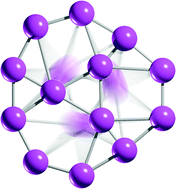Dynamical behavior of boron clusters†
Abstract
Several of the lowest energy structures of small and medium sized boron clusters are two-dimensional systems made up of a pair of concentric rings. In some cases, the barriers to the rotation of one of those rings relative to the other are remarkably low. We find that a combination of electronic and geometrical factors, including apparently the relative sizes and symmetries of the inner and outer rings, are decisive for the diminished barriers to in-plane rotation in these two dimensional clusters. A sufficiently large outer ring is important; for instance, expansion of the outer ring by a single atom may reduce the barrier significantly. A crucial factor for an apparent rotation is that the σ-skeleton of the individual rings remains essentially intact during the rotation. Finally, the transition state for the rotation of the inner ring comprises the transformation of a square into a diamond, which may be linked to a mechanism suggested decades ago for the isomerization of carboranes and boranes.


 Please wait while we load your content...
Please wait while we load your content...